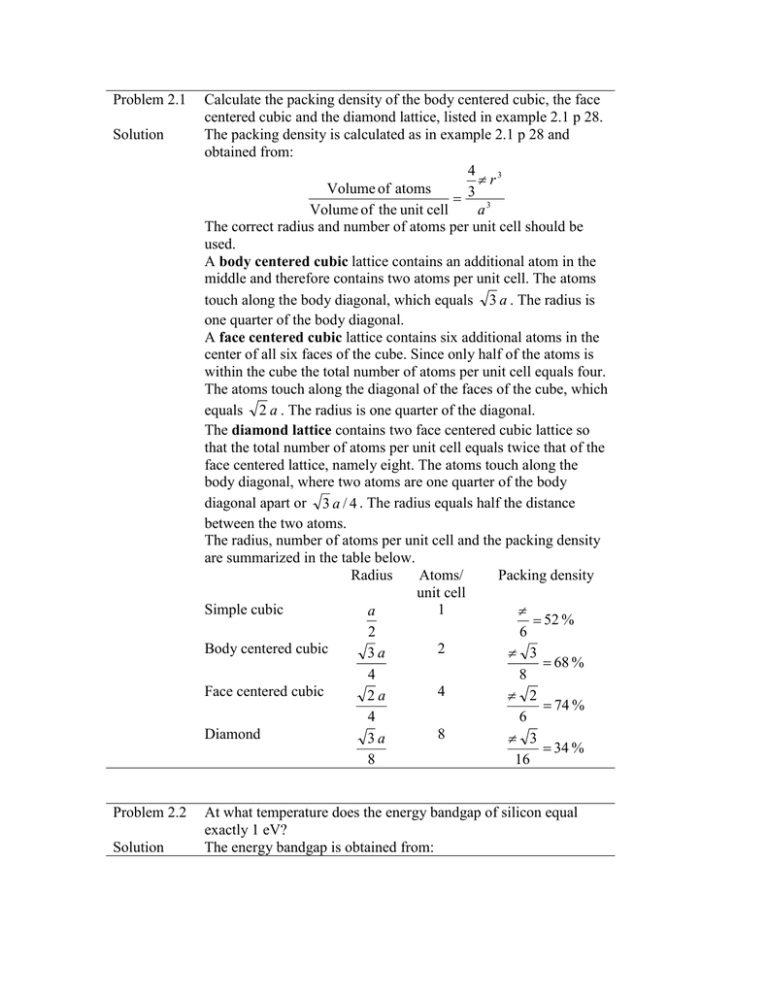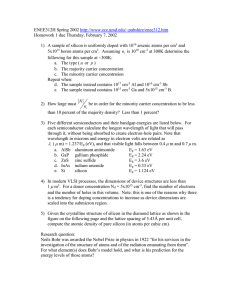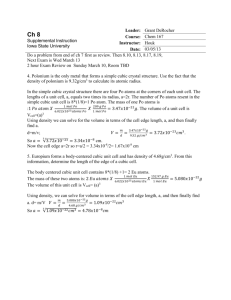Problem 2.1 Calculate the packing density of the body centered
advertisement

Problem 2.1 Solution Problem 2.2 Solution Calculate the packing density of the body centered cubic, the face centered cubic and the diamond lattice, listed in example 2.1 p 28. The packing density is calculated as in example 2.1 p 28 and obtained from: 4 3 πr Volume of atoms 3 = Volume of the unit cell a3 The correct radius and number of atoms per unit cell should be used. A body centered cubic lattice contains an additional atom in the middle and therefore contains two atoms per unit cell. The atoms touch along the body diagonal, which equals 3 a . The radius is one quarter of the body diagonal. A face centered cubic lattice contains six additional atoms in the center of all six faces of the cube. Since only half of the atoms is within the cube the total number of atoms per unit cell equals four. The atoms touch along the diagonal of the faces of the cube, which equals 2 a . The radius is one quarter of the diagonal. The diamond lattice contains two face centered cubic lattice so that the total number of atoms per unit cell equals twice that of the face centered lattice, namely eight. The atoms touch along the body diagonal, where two atoms are one quarter of the body diagonal apart or 3 a / 4 . The radius equals half the distance between the two atoms. The radius, number of atoms per unit cell and the packing density are summarized in the table below. Radius Atoms/ Packing density unit cell Simple cubic 1 a π = 52 % 2 6 Body centered cubic 2 3a π 3 = 68 % 4 8 Face centered cubic 4 2a π 2 = 74 % 4 6 Diamond 8 3a π 3 = 34 % 8 16 At what temperature does the energy bandgap of silicon equal exactly 1 eV? The energy bandgap is obtained from: E g (T ) = E g (0 K ) − αT2 T +β 0.473 × 10 −3 × T 2 = 1.0 eV T + 636 This quadratic equation can be solved yielding: E g (0 K ) − E g (T ) T= 2α E g (0 K ) − E g (T ) 2 β ( E g (0 K ) − E g (T )) + ( ) + = 679 K α 2α which is consistent with Figure 2.3.5 = 1.166 − Problem 2.6 Solution Calculate the effective density of states for electrons and holes in germanium, silicon and gallium arsenide at room temperature and at 100 °C. Use the effective masses for density of states calculations. The effective density of states in the conduction band for germanium equals: 2 π me*kT 3 / 2 Nc = 2 ( ) h2 = 2( 2 π 0.55 × 9.11 × 10 − 31 × 1.38 × 10 − 23 × 300 3 / 2 ) (6.626 × 10 − 34 ) 2 = 1.02 × 10 25 m - 3 = 1.02 × 1019 cm - 3 where the effective mass for density of states was used (Appendix 3). Similarly one finds the effective densities for silicon and gallium arsenide and those of the valence band, using the effective masses listed below: Germanium Silicon Gallium Arsenide me/m0 0.55 1.08 0.067 Nc (cm-3) 1.02 x 1019 2.81 x 1019 4.35 x 1017 me/m0 0.37 0.81 0.45 Nv (cm-3) 5.64 x 1018 1.83 x 1019 7.57 x 1018 The effective density of states at 100 °C (372.15 K) are obtain from: T 3/ 2 N c (T ) = N c (300 K ) ( ) 300 yielding: T = 100°C Germanium Silicon Gallium Arsenide Nc (cm-3) 1.42 x 1019 3.90 x 1019 6.03 x 1017 Nv (cm-3) 7.83 x 1018 2.54 x 1019 1.05 x 1018 Problem 2.7 Solution Calculate the intrinsic carrier density in germanium, silicon and gallium arsenide at room temperature (300 K). Repeat at 100 °C. Assume that the energy bandgap is independent of temperature and use the room temperature values. The intrinsic carrier density is obtained from: − Eg ni (T ) = N c N v exp( ) 2kT where both effective densities of states are also temperature dependent. Using the solution of Problem 2.6 one obtains: T = 300 K Germanium Silicon Gallium Arsenide ni (cm-3) 1.78 x 1013 8.81 x 109 1.97 x 106 T = 100°C Germanium Silicon Gallium Arsenide Nv (cm-3) 3.14 x 1014 8.55 x 1011 6.04 x 108







